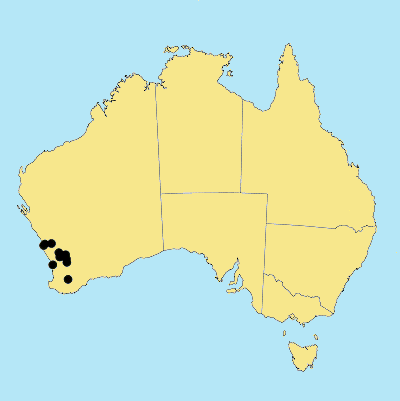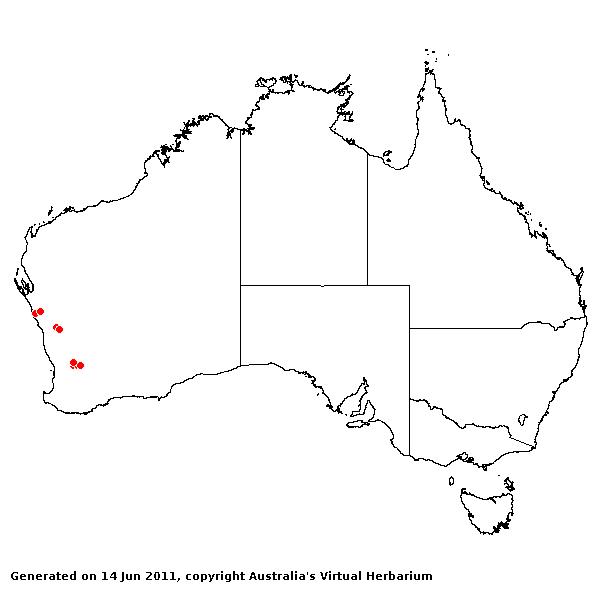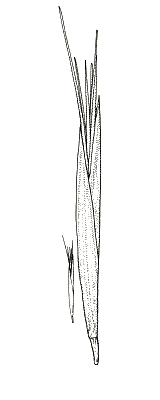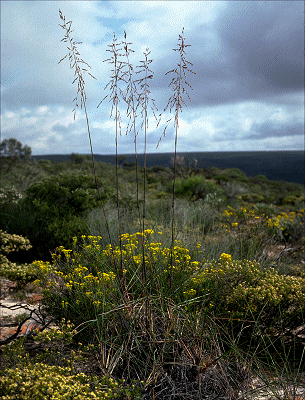Triodia longipalea M. Lazarides, nom nov. Austral. Syst. Bot. 10: 448–449 (1997). Classification. (GPWG 2001) : Subfamily Chloridoideae. Triodeae.
Basionym and/or
Replacement Name: Plectrachne
drummondii C.E. Hubb., Bull. Misc. Inform. Kew 1941: 26 (1941).
Type of Basionym or
Protologue Information: Australia: Western Australia: South-Western
Province; Swan River, without precise locality, Drummond 128 (HT: K).
Key references
(books and floras): [1952] C.A.Gardner, Flora of Western Australia 1
Gramineae (81 as Plectrachne. drummondii), [2002] D.Sharp &
B.K.Simon, AusGrass, Grasses of Australia.
Illustrations:
[2005] K.Mallet (ed.), Flora of Australia 44B: Poaceae 3 (Fig.
37Q-R).
Habit.
Perennial. Culms erect, 100–250 cm tall. Lateral branches simple. Leaf-sheaths
smooth, glabrous on surface. Leaf-sheath auricles absent. Ligule a fringe of
hairs. Leaf-blades curved, aciculate, conduplicate, 25–54 cm long, 1–2 mm wide.
Leaf-blade surface glabrous.
Inflorescence.
Inflorescence compound, a panicle. Panicle linear or lanceolate or oblong,
28–60 cm long, 2.5–5 cm wide.
Spikelets.
Spikelets pedicelled. Fertile spikelets many flowered, with at least 2 fertile
florets (4–7), comprising 4–7 fertile floret(s), with diminished florets at the
apex, elliptic, laterally compressed, 15–21 mm long.
Glumes.
Glumes similar. Lower glume lanceolate, scarious, without keels, 3–9 -nerved.
Lower glume surface glabrous. Lower glume apex muticous or mucronate. Upper
glume lanceolate, 10–16 mm long, scarious, without keels, 3–9 -nerved. Upper
glume surface glabrous. Upper glume apex entire, muticous or mucronate.
Florets.
Fertile lemma 6–10 mm long, without keel, 3–15 -nerved. Lemma surface
indumented. Lemma apex lobed, awned, 3 -awned. Median (principal) awn 11–13 mm
long overall. Lateral lemma awns present. Palea 2 -nerved. Lodicules present.
Anthers 3.
Continental
Distribution: Australasia.
Australian
Distribution: Western Australia.
Western Australia:
Irwin, Drummond, Avon.
Notes.
Distinguishing characters include the robust habit; long, narrow panicle;
glumes scarious, shorter than spikelet, brown; spikelet loosely 6–10-flowered;
lemma sparsely hairy along midnerve and submargins; palea longer than the body
of its lemma; anthers large; caryopsis concavo-convex, much longer than wide,
with prominent embryo. Similar to P. dielsii but P. dielsii has a
spreading panicle and a lemma which is hirsute also along the lateral nerves as
well as on the midnerve and submargins.
Central
South-West Province of W.A. On sand plains and ridges often in white sand, near
salt flats and on limestone pavements; associated with heath, scrub and
woodland; flowers Sept.-Feb., but not recorded in Dec.; fruits Sept.-Feb., but
not recorded in Dec.




